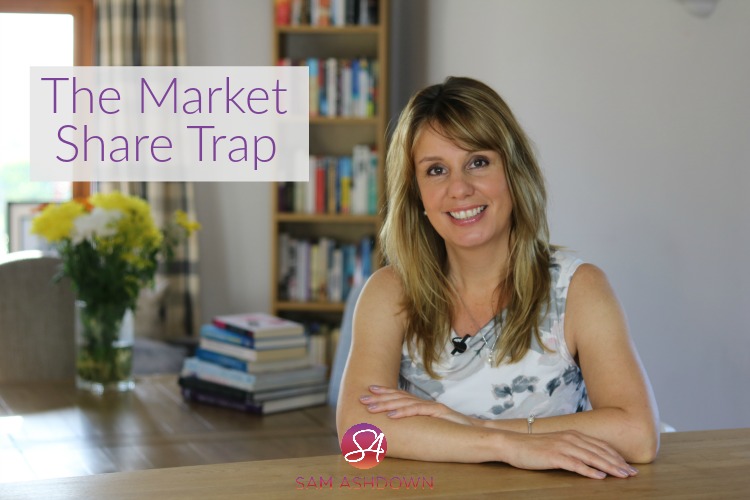There are 8 million people living in Switzerland – compared with China (1.3 billion) and the US (320 million) it’s absolutely tiny. If you were a watch manufacturer you could be forgiven for dismissing the country’s watch brands as a threat to you. After all, Swiss watch companies only manufacture 2% of the world’s watches, so how can they compete with the likes of Timex and Accurist?
A 2% market share hardly makes Switzerland a credible player in the world watch industry, but 54% does. Swiss watches altogether account for an incredible 54% of the global watch market by value. How can that be? Because they don’t pursue market share by volume; they seek to make the highest value watches in the world. With an average Swiss watch retailing at over £5,000, they focus all of their efforts on making the best watches in the world. And they have the profit margins to do it.
Think about it; if you can charge higher than anyone else for your product or service, you can sell less of them. Less volume means more time to focus on attaining the highest possible level of quality. It also means less staff, smaller premises, and crucially less customers needed to make a profit.
Let’s look at an example closer to home: the supermarket industry. Tesco is known for its aggressive pursuit of market share, and it sits comfortably at the top of the volume market, with a £50 billion turnover last year. From this colossal figure, just £162m is profit. On the other hand, Waitrose, with its focus on quality and store experience, brought in 12% of Tesco’s revenue, but still reported an £80 million profit – half that of Tesco’s. Clearly, Waitrose can operate with much lower costs than Tesco: smaller stores, fewer product lines, and less staff.
A value market share is a much better goal than a volume market share. I recently presented at the Network Auctions annual conference alongside Perry Power from Power Bespoke. He said something that really resonated with me: “We don’t need to win every instruction; just enough instructions. “
The allure of pursuing market share is a trap.
It’s expensive in terms of marketing and resources, and it drives down fees. It leads to turnover for the sake of turnover. So you could be bringing in instructions by the boatload, but they will be low quality, and low fee.
The difference between a successful agent and a struggling agent is this: the successful agent is prepared to walk away from the wrong instruction.
Leaving the wrong instruction on the table is really powerful; it takes you a step closer to the next right instruction. The right instructions come from clients who will truly value your service, and all that is entailed in it: your advice, your marketing and your company values. The wrong instructions value only one thing: the money. If you are going to be judged entirely on your fee and valuation, and your service just isn’t part of their decision-making process, then you know it’s the wrong instruction for you.
I recently created a Stock Analysis template for a client who was struggling with too many of the wrong kind of instructions on her list. (See the bottom of this post for instructions on how to get a copy.)
I only work with a particular kind of agent: they have to be independent, not corporate; they need to be open-minded to new ideas and passionate about their agency. They have to be decisive, and take action quickly and boldly.
Does this reduce the potential number of clients I can work with? Hell yes! I could probably treble my volume if I was less restrictive. But why would I want to do that? More money? Possibly, but not a certainty. More headaches? Definitely. A lower level of support and mentoring to my current clients? Absolutely, and that’s something I would never be happy about.
My model is all about serving my clients at the highest level they need at that particular time. I’ve visited their offices, trained their staff, spoken at their events, taken them to dinner, had long late-night chats, lent them my team, hosted client days for them and lots more besides, all at no extra cost to them. And that makes us both happy. I can only do this because I choose to work with a small number of clients in a very personal way. And so can you.
But how can you be selective?
One of my clients called me recently from outside a valuation appointment. “I don’t think I really want this one”, she told me. She explained that the homeowner had been a bit difficult when arranging the appointment, and that it had already been on the market with another agent for several months. It was a nice property, recently marketed at £350,000.
“What should I do?” she asked.
“Over-fee and under-value” I told her.
So she did. She went in at 1.8% and told the vendor the price needed to come down to £300,000.
Guess what happened? Yep. She got it. BUT – at an asking price she could sell and a fee that would make a needy vendor worth the extra time and effort.
What would it mean to you to be selective?
You would have more time for the same profit – or even more – than you currently show. Your team would be more relaxed; not running around like headless chickens. You would be proud of your register, which would be full of lovely properties that showcase your brand. Your marketing would be educative, created to attract leads, not the me-me-me mass leafleting style. And the bottom line is that with a sustainable model like this, you can grow your agency without stress and overwhelm.
If you’d like to take a look at the Stock Analysis template I’ve created, together with a short tutorial on how to use it, please email me and I’ll send it to you.

What to read next: The Pumpkin Plan Formula
What to do next: Do you get my Supertips? They’re jam-packed full of great tips and marketing strategies just like this one, and best still – they’re free! Get yours here -> www.samashdown.co.uk/samsupertips
Speak to Sam: If you’d like to know how I think you could improve your marketing, just answer a few short questions here and I’ll tell you if and how you could be more effective.


